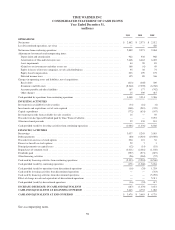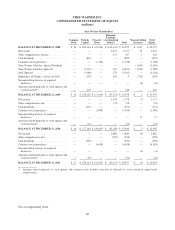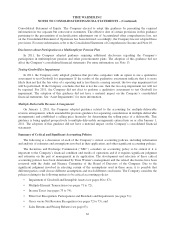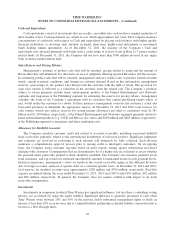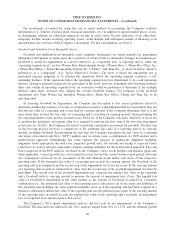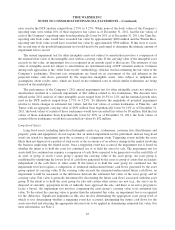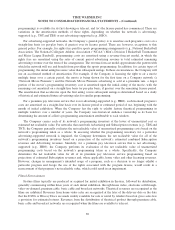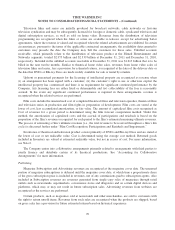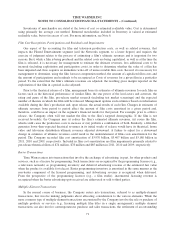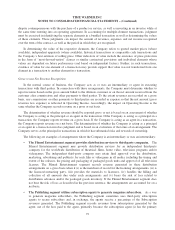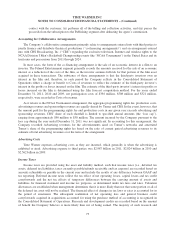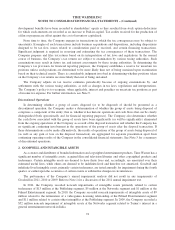Time Magazine 2011 Annual Report Download - page 83
Download and view the complete annual report
Please find page 83 of the 2011 Time Magazine annual report below. You can navigate through the pages in the report by either clicking on the pages listed below, or by using the keyword search tool below to find specific information within the annual report.TIME WARNER INC.
NOTES TO CONSOLIDATED FINANCIAL STATEMENTS – (Continued)
programming) is available for its first showing or telecast, and (iv) the license period has commenced. There are
variations in the amortization methods of these rights, depending on whether the network is advertising-
supported (e.g., TNT and TBS) or not advertising-supported (e.g., HBO).
For advertising-supported networks, the Company’s general policy is to amortize each program’s costs on a
straight-line basis (or per-play basis, if greater) over its license period. There are, however, exceptions to this
general policy. For example, for rights fees paid for sports programming arrangements (e.g., National Basketball
Association, The National Collegiate Athletic Association (“NCAA”) Men’s Division I Basketball Tournament
and Major League Baseball), programming costs are amortized using a revenue-forecast model, in which the
rights fees are amortized using the ratio of current period advertising revenue to total estimated remaining
advertising revenue over the term of the arrangement. The revenue-forecast model approximates the pattern with
which the network will use and benefit from providing the sports programming. In addition, for certain types of
programming, the initial airing has more value than subsequent airings. In these circumstances, the Company will
use an accelerated method of amortization. For example, if the Company is licensing the right to air a movie
multiple times over a certain period, the movie is being shown for the first time on a Company network (a
“Network Movie Premiere”) and the Network Movie Premiere advertising is sold at a premium rate, a larger
portion of the movie’s programming inventory cost is amortized upon the initial airing of the movie, with the
remaining cost amortized on a straight-line basis (or per-play basis, if greater) over the remaining license period.
The amortization that accelerates upon the first airing versus subsequent airings is determined based on a study
of historical and estimated future advertising sales for similar programming.
For a premium pay television service that is not advertising-supported (e.g., HBO), each licensed program’s
costs are amortized on a straight-line basis over its license period or estimated period of use, beginning with the
month of initial exhibition. When the Company has the right to exhibit feature theatrical programming in
multiple windows over a number of years, the Company uses historical audience viewership as its basis for
determining the amount of a film’s programming amortization attributable to each window.
The Company carries each of its network’s programming inventory at the lower of unamortized cost or
estimated net realizable value. For networks that earn both Advertising and Subscription revenues (e.g., TBS and
TNT), the Company generally evaluates the net realizable value of unamortized programming costs based on the
network’s programming taken as a whole. In assessing whether the programming inventory for a particular
advertising-supported network is impaired, the Company determines the net realizable value for all of the
network’s programming inventory based on a projection of the network’s estimated combined Subscription
revenues and Advertising revenues. Similarly, for a premium pay television service that is not advertising-
supported (e.g., HBO), the Company performs its evaluation of the net realizable value of unamortized
programming costs based on the network’s programming taken as a whole. Specifically, the Company
determines the net realizable value for all of its premium pay television service programming based on
projections of estimated Subscription revenues and, where applicable, home video and other licensing revenues.
However, changes in management’s intended usage of a program, such as a decision to no longer exhibit a
particular program and forego the use of the rights associated with the program license, would result in a
reassessment of that program’s net realizable value, which could result in an impairment.
Filmed Entertainment
Feature films typically are produced or acquired for initial exhibition in theaters, followed by distribution,
generally commencing within three years of such initial exhibition, through home video, electronic sell-through,
video-on-demand, premium cable, basic cable and broadcast networks. Theatrical revenues are recognized as the
films are exhibited. Revenues from home video sales are recognized at the later of the delivery date or the date
that the DVDs or Blu-ray Discs are made widely available for sale or rental by retailers based on gross sales less
a provision for estimated returns. Revenues from the distribution of theatrical product through premium cable,
basic cable and broadcast networks are recognized when the films are available to telecast.
69


